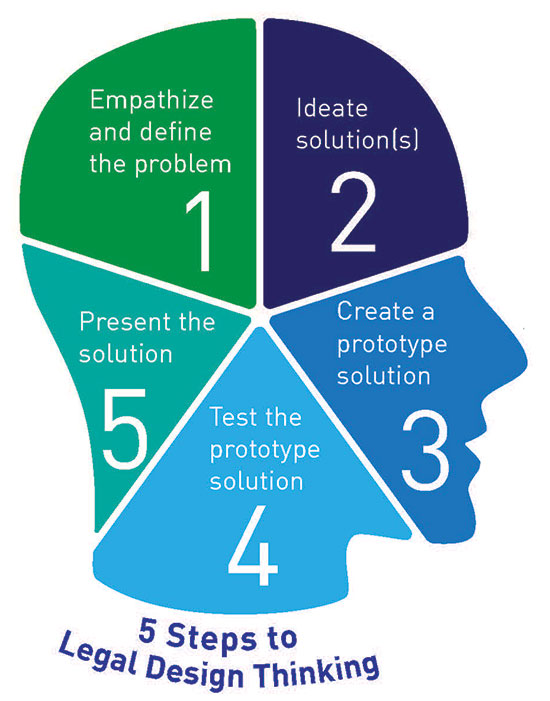 The legal industry is notoriously slow to embrace change. This tendency toward risk aversion has arguably served clients reasonably well in the delivery of legal services. On the other hand, it may have curbed lawyers’ ability to reenvision how to build a practice more adaptive to clients’ ever-changing needs amid disruptive changing market conditions.1 This drawback necessitates an approach to legal practice in a more dynamic, innovative, and cutting-edge manner.2
The legal industry is notoriously slow to embrace change. This tendency toward risk aversion has arguably served clients reasonably well in the delivery of legal services. On the other hand, it may have curbed lawyers’ ability to reenvision how to build a practice more adaptive to clients’ ever-changing needs amid disruptive changing market conditions.1 This drawback necessitates an approach to legal practice in a more dynamic, innovative, and cutting-edge manner.2
Enter design thinking, an approach used by engineering and technology companies for many years but now also being applied to the legal industry.3 Legal design thinking is a tool that can greatly improve the range of solutions that lawyers should offer their clients.
Traditional Legal Model Versus Design Thinking Model
“What is legal design thinking?” you might ask. Simply put, legal design thinking is an innovative problem-solving methodology being taught at leading U.S. law schools such as Stanford Law School.4 It aims to improve and simplify how lawyers engage and respond to clients’ needs. Essentially, it is a human-centered approach that identifies a client’s needs, then designs a custom solution to achieve the most favorable outcome.5
This method contrasts with traditional models of legal thinking in which a client’s expressed desire for a particular solution is applied to legal problems that, because of existing frameworks, fall within similar categories, with little or no experimenting with other creative alternatives beyond those predictable outcomes. In addition, legal design thinking is relationship oriented, meaning that the lawyer approaches the problem from the participants’ viewpoint instead of making assumptions about what the problem might be.
Although design thinking is often associated with adapting to technological changes, the approach is more encompassing. It also involves collaboration with professionals who have diverse skill sets, often yielding new and different ways to approach a problem, such as redesigning a process, leveraging existing technology differently, or designing new technology. This approach is not only innovative and useful but also participatory and engaging for those involved.
5 Steps to Legal Design Thinking
Typically, design thinking has five core steps:
- Empathize and define the problem,
- ideate solution(s),
- create a prototype solution,
- test the prototype solution, and
- present the solution.
The first step is designed to understand the problem at issue. This brainstorming step has lawyers identify the specific client problem by asking questions of all applicable stakeholders. The scope is to gather as much information about the issue as possible. The second step is to envision and imagine possible solutions to the problem. The third and fourth steps are to prioritize, build, and test those solutions identified as viable to determine whether they accurately and efficiently solve the problem. The final step is to present the solution(s) to the client in a medium and manner that the client understands and allows the client to make informed decisions.
|
Traditional Legal Model (Problem Based)
|
Design Thinking Model (Solution Based)
|
-
Identify issue based on experience from previous scenarios and matters
-
Identify desired outcome, without much input from participants
-
Apply predetermined solution(s)
-
Analyze how solution(s) may have worked in the past
-
Reach conclusion
|
-
Empathize and define problem with open-mindedness
-
Ideate solution(s) that emphasize creative, new possibilities
-
Develop prototypes based on creative input
-
Test in a way that adapts to current set of facts and participants
-
Present solution
|
Applying Legal Design Thinking
During the recent State Bar of Wisconsin Annual Meeting & Conference, the State Bar’s International Practice Section sponsored a program to put legal design thinking into action. Through the CLE-eligible course, titled Legal Design Thinking: A New Approach to Advising Clients, attendees participated in an interactive learning session rather than the traditional lecture-and-questions format.
 Ngosong Fonkem, West Virginia 2011 (JD, MBA), Tulane 2012 (LL.M.), is a senior advisor at Addison-Clifton LLC, Milwaukee. He assists U.S. and foreign companies with compliance with U.S. trade laws and with doing business in Asia.
Ngosong Fonkem, West Virginia 2011 (JD, MBA), Tulane 2012 (LL.M.), is a senior advisor at Addison-Clifton LLC, Milwaukee. He assists U.S. and foreign companies with compliance with U.S. trade laws and with doing business in Asia.
 Bethany Wilson, U.W. 2017, is an associate at Palmersheim Dettmann SC, Middleton, where she focuses on general corporate law and international law.
Bethany Wilson, U.W. 2017, is an associate at Palmersheim Dettmann SC, Middleton, where she focuses on general corporate law and international law.
 Kristen Hardy, Marquette 2014, is legal counsel at Briggs & Stratton Corp., Wauwatosa. She leads the anti-bribery/anti-corruption, international trade, and integrity practice groups.
Kristen Hardy, Marquette 2014, is legal counsel at Briggs & Stratton Corp., Wauwatosa. She leads the anti-bribery/anti-corruption, international trade, and integrity practice groups.
 Jeff Perzan, Columbia Law School 1985, and Parker School of Foreign and Comparative Law, is principal at the Law Offices of Jeffrey Perzan, Milwaukee, concentrating in outsourcing, licensing, mergers and acquisitions, and dispute resolution, both domestic and international.
Jeff Perzan, Columbia Law School 1985, and Parker School of Foreign and Comparative Law, is principal at the Law Offices of Jeffrey Perzan, Milwaukee, concentrating in outsourcing, licensing, mergers and acquisitions, and dispute resolution, both domestic and international.
Attendees were divided into groups of approximately four people, randomly selected when entering the room. Each group was asked to use legal design thinking in advising a client. The groups were challenged to find a creative solution for their client, ABC Company, with respect to a border dispute between two provinces in a small country. Each International Practice Section member-lawyer played a different role to aid attendees in developing an effective solution – political officials representing opposing provinces as well as the fictitious country’s leader.
Attendees were given time to ask questions, brainstorm solution(s), and eventually present their solution(s) and findings at the close of the session. Finally, every group member voted by ranked choice for the most effective and creative solution (excluding their own group), and the “winning” team received a nominal prize.
Applying Legal Design Thinking to Law Firm and Consulting Settings
Import Compliance Obligations. Let’s apply the problem-solving approach using a practical example. A manufacturer of pharmaceutical ingredients sought Addison-Clifton’s help to assist it with its compliance obligations required by U.S. Customs and Border Protection (CBP). CBP had imposed financial penalties for alleged filing of inaccurate import data in import documentations. Thus, the company wanted to shore up its import-filing process as a corrective action measure and become compliant.
Meet Our Contributors
Why do you do what you do? What's the best advice you ever received? Share your weirdest courtroom story...
Lawyers have a lot to say. Our authors are no exception. Whether its personal, insightful, or fun, it’s always interesting.
Check out our Q&A with the author below
Under the traditional method of problem solving, the company would focus on the particular cause of inaccurate import data filing, such as an employee error, then focus on ways to correct that issue. Using legal design thinking, however, an initial review and risk assessment of the company’s import-filling process was conducted by asking not only the company, but also CBP, several questions in order to get a clearer picture of the issues causing the violation.
The categories of questions included the following: 1) the laws allegedly violated; 2) CBP requirements, including the timeline to disclose and remedy the alleged violation; 3) circumstances surrounding the issue (who, what, when, where, and why); 4) risks to the company; and 5) processes and procedures that were in place or should be in place to prevent future infractions.
Based on these questions, a root-cause analysis of the company’s importing and manufacturing processes was conducted to ascertain the origins of the problems and existing internal process bottlenecks and shortcomings. The analysis also determined at which stages process simplifications and defection elimination would reduce the likelihood of issues recurring.
The second step was to ideate possible solutions. Essentially, the actual quantity of imported product was not known at the time of initial import documentation filing with CBP. The problem arose primarily because the company did not have a process to amend its import-filing documents when the actual quantity of imported products became known, which was only after manufacturing took place. CBP’s mandated deadline to file a post-entry amendment to the initial entry filings would have passed by the time the quantity of imports was determined.
To solve this problem, Addison-Clifton designed a solution that involved tracking each imported shipment, then later filing a post-entry amendment with CBP. This solution involved working collaboratively with the company and CBP to ensure that the correct data was properly captured in the initial import-filing documents, and at a later agreed date, filing a post-entry amendment with CBP. This step was crucial because the company’s manufacturing process was unique.
Legal design thinking … provides an interactive methodology and outcome-based solution to enable lawyers to achieve better client outcomes, interactions, and satisfaction.
Remote Supervision of U.S.-based Sales Agents. Another example illustrating this approach involved a Chinese company that hired sales agents in the United States to sell products to U.S. farmers. Because the client primarily resides abroad, it struggled to motivate these agents to sell products without persistent supervision. As a result, the company invested substantial capital in its U.S. operations but did not realize noticeable returns. The company sought Palmersheim Dettmann’s assistance to find a creative solution to this problem.
Under the traditional method of problem solving, the parties involved would focus solely on instituting policies that had worked in other circumstances but were not tested in the United States. Using the design thinking approach, the law firm and the client obtained information from all stakeholders to determine the company’s sales goals and assess the challenges inhibiting its sales agents from reaching sales targets.
Based on this analysis, the law firm and the client determined that because the agents’ compensation structure was based solely on a flat-salary model, the agents had minimal financial incentive to pursue sales opportunities aggressively. Many possible solutions were explored through brainstorming, such as terminating the agents and hiring new ones, finding a more reliable U.S.-based manager, and even shutting down U.S. operations entirely.
However, given the nature of the business and the company’s goals, the most viable solution, which had not been tried before, was to reduce the agents’ base salary and add a commission component to the compensation package. Further, the agents were required to use a GPS mobile application, installed on their cell phones, to self-monitor their movements during work hours at the office and on sales trips. Although minor, these adjustments improved the agents’ sales output and enabled the company to motivate its agents while overseeing operations from China.
Applying Legal Design Thinking to In-house Settings
Using legal design thinking to solve problems is not limited to outside counsel and consulting firms; in-house counsel can also use this approach to improve processes, identify and mitigate risks, and update procedures.
Consider a Fortune 500 Company that requires a formalized company-wide training plan, as noted by outside auditors. To begin, the employment lawyer or chief compliance officer would need to conduct an initial review and assessment of the current training offerings. What training currently exists? Which laws or regulations inform such training? Who receives the training and how frequently? Which topics are currently missing? Lawyers, in conjunction with human resources staff, must also consider plan ownership, plan execution, and other stakeholders needed to set the plan in motion.
After gathering pertinent information from key stakeholders, in-house counsel can use this information to map and test possible plans. This may require asking for additional funding to build a training platform. In this instance, the detailed steps of legal design thinking can serve as a solid business case for sufficient funds in the budget to pay for a tool or system for the training plan. Or perhaps, a simple Microsoft Excel, Word document, or Powerpoint presentation will meet the organization’s needs and help keep it in compliance with relevant regulations. The final steps require testing and, ultimately, buy-in from key stakeholders to implement the plan.
Conclusion
Amid evolving legal market conditions, lawyers who adapt and proactively embrace change will have a competitive advantage over more traditional or risk-averse lawyers. The legal design thinking approach outlined here provides an interactive methodology and outcome-based solution to enable lawyers to achieve better client outcomes, interactions, and satisfaction in a variety of settings and situations.
Meet Our Contributors
Your practice focuses on international trade. What drew you to that practice area?
 I have a passion for international trade and the desire to be an industry leader in the field. In my current role as senior advisor at Addison-Clifton, I advise U.S. and foreign companies regarding compliance with U.S. export and import regulations and doing business abroad.
I have a passion for international trade and the desire to be an industry leader in the field. In my current role as senior advisor at Addison-Clifton, I advise U.S. and foreign companies regarding compliance with U.S. export and import regulations and doing business abroad.
Perhaps that passion for international trade stems from my background (I was born in Cameroon) and my fascination with different cultures and traditions. This led me to moving after law school to Southeast Asia, where I had the opportunity to not only teach as a full-time member of the faculty of law at the oldest private university in Malaysia but also work as a business development consultant for a French energy-intelligence management consulting company.
I continue to participate at international-trade-promotion and cultural-exchange initiatives in Wisconsin, all of which have been a transformative experience.
Ngosong Fonkem, Addison-Clifton LLC, Milwaukee.
What is your favorite nonwork activity?
 Traveling to foreign countries. Since my first trip to Denmark in 2004, I have become addicted to the feeling of being in an environment where my brain is constantly challenged. I also get a sense of freedom in wandering aimlessly, unsure about what exactly is happening around me.
Traveling to foreign countries. Since my first trip to Denmark in 2004, I have become addicted to the feeling of being in an environment where my brain is constantly challenged. I also get a sense of freedom in wandering aimlessly, unsure about what exactly is happening around me.
One of my most memorable travel experiences was spending a whole day trying to reach a mountain outside of Shenzhen, China. When I finally reached the base of the mountain, a kind lychee farmer shared a bucket of lychees with me. Another memorable experience was crossing through the Democratic Republic of the Congo to reach the other side of Zambia, the country where I was staying. Not only did our driver keep forgetting to drive on the right-hand side of the road instead of the left (because the DRC was a Belgian colony and Zambia was a British colony), we got stuck at the border and had to “persuade” the officials to let us through before the border closed at 6 p.m. These moments of uncertainty in foreign countries make me feel human.
Bethany Wilson, Palmersheim Dettmann SC, Middleton.
What’s your favorite nonwork activity?
 I love a good fitness session. I’m more partial to working up a sweat after work, but I’ve recently found myself doing 30-minute classes over the lunch hour. I used to be very anti-group fitness, but in recent years, I’ve gotten into high-intensity interval training and muscle-conditioning classes. A good trainer coupled with good energy from those around you makes for a healthy, fun, and productive extracurricular activity.
I love a good fitness session. I’m more partial to working up a sweat after work, but I’ve recently found myself doing 30-minute classes over the lunch hour. I used to be very anti-group fitness, but in recent years, I’ve gotten into high-intensity interval training and muscle-conditioning classes. A good trainer coupled with good energy from those around you makes for a healthy, fun, and productive extracurricular activity.
Kristen Hardy, Briggs & Stratton Corp., Wauwatosa.
What’s your favorite part of Wisconsin?
 On a rooftop overlooking Lake Michigan with French cheese and a glass of wine.
On a rooftop overlooking Lake Michigan with French cheese and a glass of wine.
Jeff Perzan, Law Offices of Jeffrey Perzan, Milwaukee.
Become a contributor! Are you working on an interesting case? Have a practice tip to share? There are several ways to contribute to Wisconsin Lawyer. To discuss a topic idea, contact Managing Editor Karlé Lester at (800) 444-9404, ext. 6127, or email klester@wisbar.org. Check out our writing and submission guidelines.
Endnotes
1 Thomson Reuters, Overcoming Lawyers’ Resistance to Change, (last visited Aug. 5, 2019).
2 Thomson Reuters, Rebuilding the Law Firm Model: “2019 Report on the State of the Legal Market” From Georgetown Law and Thomson Reuters Legal Executive Institute (Jan. 9, 2019).
3 Baker McKenzie launched an innovation “hub,” Whitespace Legal Collab, in Toronto in 2017. Baker McKenzie, Baker McKenzie Named Among Most Innovative Firms by Financial Times (Dec. 12, 2017).
4 Stanford Law School, The Legal Design Lab, (last visited Aug. 5, 2019).
5 IDEO U, Unlock Your Creative Potential Through IDEO U, (last visited Aug. 5, 2019).
